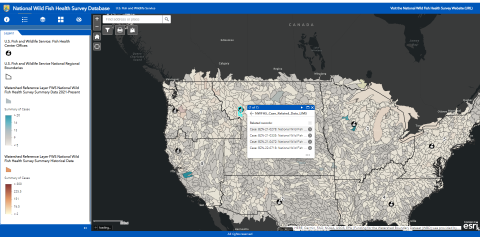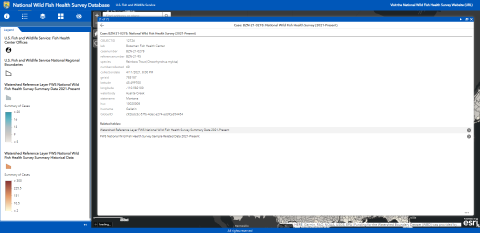National Wild Fish Health Survey Data
To view the data outside of the web application, please see the National Wild Fish Health Survey pre-Laboratory Information System feature layer's (1996-2020) data table and see the National Wild Fish Health Survey Laboratory Information System feature layer's (2021-present) data table.
Survey Assumptions and Limitations on Data Use
The National Wild Fish Health Survey (Survey) is performed under certain assumptions and pathogen test results carry certain limitations of use that need to be understood before drawing conclusions from the information maintained in the database. Important topics related to these assumptions and limitations are discussed below.
Data Usage Disclaimer
Every effort has been made to provide accurate and complete data, but keep in mind the following caveat: The U.S. Fish and Wildlife Service (USFWS) shall not be held liable for improper or incorrect use of the data described and/or contained herein. These data are not legal documents and are not intended to be used as such. The information contained in the database is dynamic and changes over time. It is the responsibility of the data user to use the data appropriately and consistently within the limits of the data. Conclusions drawn from use of this data are the user's responsibility. The USFWS provides no warranty, expressed or implied, as to the accuracy, reliability, or completeness of the data. Although these data have been processed successfully on a computer system at the U.S. Fish and Wildlife Service, no warranty expressed or implied is made regarding the utility of the data on another system or for general or scientific purposes, nor shall the act of distribution constitute any such warranty. This disclaimer applies both to individual use of the data and consolidated use with other data.
Collection of Fish and Tissue Samples from Target Populations
The term "wild fish"; in the title of this Survey is used in a broad sense. In most cases, fish are collected from free-ranging and generally self-sustaining populations considered to be wild or feral. Both native and non-native or introduced species are sampled. Additionally, populations maintained by stocking or periodic supplementation with hatchery-reared fish are sampled when those fish have been living in the natural environment for a considerable period of time. Fish and associated tissue samples are collected by the Service network of regional Fish Health Centers or by cooperating partners knowledgeable of Survey protocols and procedures. Survey partners include other Federal resource agencies, State agencies, natural resource departments of Tribes, and several non-governmental entities involved with managing or monitoring free-ranging fish. In some instances, Service Fish Health Center personnel either lead or assisted in the collection of fish and tissue samples and in other instances these operations are performed entirely by the Survey partner. The Service necessarily assumes that for collections outside its direct control fish were properly identified, sample locations were accurately recorded, and tissue samples were collected according to approved standard methods.
Sampling Design and Limitations on Statistical Inferences
Users of the database should exercise caution when attempting to make inferences from Survey results because many requirements and assumptions of rigorous statistical analyses are not met with the present sampling design. Much of Survey sampling is considered opportunistic and often coincides with specific partner needs and/or objectives. Those needs may or may not satisfy sampling assumptions for calculating various statistical estimates from test results. It is also important to note that the Survey is not presently based on a nation-wide systematic sampling plan and in most cases, samples are not drawn from populations using completely randomized designs. Sixty fish of any species collected at a single location is often cited as an acceptable sample size for routine health inspections and in disease surveillance programs. The 60 fish target is based on a 95% confidence level of detecting one infected fish given a presumed pathogen prevalence of 5% and a population size of at least 2000 individuals. While best efforts are made in the Survey to obtain meaningful sample sizes there are many cases where sample size is less than 60 fish. In large scale field survey such as this the investigator must often speculate on sample parameters because information on actual population size and pathogen prevalence, if any, is usually unknown. Many sample sites have only been sampled once and thus only provide a snapshot in time. Attempts to make statistical inferences requiring repeated measures are not likely valid. The database does record for each collection whether the sampling was routine or if it motivated by a particular purpose such as observation of disease or investigation of a fish kill (contact identified Fish Health Center directly for more information).
Methodology Considerations
The database contains records on the presence or absence of fish pathogens or major antigens of fish pathogens. No assay is considered 100% accurate on all accounts and therefore a small probability exists where a Survey result could be either falsely negative or falsely positive.
Number of Fish that are the Basis for a Result
The database reports results on the number of samples tested which may be different from the actual number of fish tested (sampled). In some cases, not all fish collected at a particular location are used in every available assay. Some fish in the sample may not be the appropriate size or age for a particular test or there may not be sufficient amount of tissue to run the full battery of available assays. Additionally, preliminary assays for several fish pathogens are performed on pooled tissue samples collected from up to five fish. Pooled tissue samples are commonly used in cell cultures assays for viruses and in the enzymatic digest procedure for salmonid whirling disease. For purposes of this Survey, a tissue sample is referred to as a "pool"; and may contain representative tissue from 1 to 5 individual fish. In any respect, the actual number of fish contributing to each pool is recorded in the database. The tracking of individual fish through the various tissue pools is at laboratory discretion on a case-by-case basis.
Proportion of Fish Testing Positive
The proportion of fish testing positive for a pathogen can only be determined when tissue samples are collected individually from each fish. However, preliminary assays for several fish pathogens included in the Survey are performed on pooled tissue samples collected from 1 - 5 fish. The number of fish contributing to a pool is known; however, a positive test result only indicates that at least one fish contributing to the sample pool was positive. There is generally no way to determine the contribution of individuals within the pool unless additional individual tissue samples were collected and archived for subsequent use. If more than one fish contributes to a sample pool, the test results for that pool represent the set of fish.
Pathogen and Disease
A number of variables associated with the host, the pathogen, and the environment are important in determination of disease expression. Therefore, detection of a pathogen or its antigen in an individual fish does not necessarily indicate that the fish or the local fish population was experiencing effects of an associated disease at the time of sampling. Similarly, non-detection does not necessarily mean that the pathogen is absent from the population or that an associated disease will not be an issue at some point in the future (contact identified Fish Health Center directly for more information).
Extrapolation of Survey Results to Un-sampled Locations
Results generated from database queries, do not suggest nor imply any occurrence of the subject pathogen(s) beyond that indicated in query results for the requested fish and pathogen(s) combination(s). It is formally possible to construe a defined spatial area, such as a state or a watershed, as a statistical aggregate, and to interpret the set of test results from collections falling in that area as a statistical sample, and on this basis to calculate the frequency of that pathogen in the area as a whole. However, statistical operations interpreted in this way make many assumptions that need to be carefully considered by the user. The most serious assumption is that the sample collection locations were taken to represent a defined watershed area. Evaluation of this assumption is a difficult scientific undertaking. Sampling designs intended to represent this broader level of information require dense spatial coverage of samples and control of sampling locations. Depending on the query parameters and when the query is performed, there may be insufficient samples included within the results to validate this assumption.
Metadata
Please read metadata for Laboratory Information Systems (LIMS) Data (2021-Present)
Please read metadata for Pre-Laboratory Information Systems data (historical)
Issues or Questions?
Contact: wildfishsurvey@fws.gov







